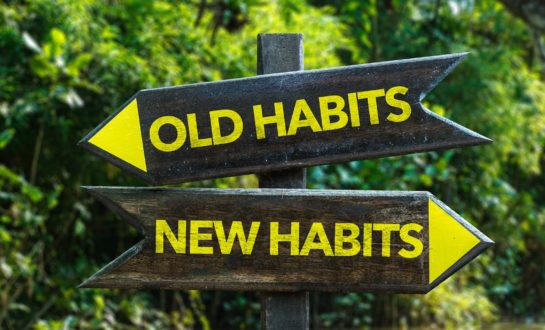

Proven ways to break success killing bad habits
Table of Contents
A big part of the quick results of Neuro Linguistic Programming (NLP) is the focus on success. In so many therapies the techniques talk about the problem, talk about the problem, talk about the problem. NLP aims to break bad habits and break them quickly.
By observing, studying and getting to the bottom of what successful people do, how they react and what their internal and external communication is, we can adopt those new patterns and create powerful and long lasting outcomes.
Often when it comes to breaking bad habits, or instilling good ones, it takes repetition, time and a lot of effort. In most cases breaking the back of these habits is just too hard, or not permanent enough for us to see it through.
There are a number of reasons behind this, including your mind’s resistance to new information (critical factor), secondary gains that the habit gives us, or an unconscious need being met.
Stop Bad Habits With NLP
With NLP techniques we bypass all three of these factors and make a simple, even instantaneous pathway to break bad habits for good.
Essentials: You have to want to change and be 100% committed to seeing it through. The change has got to be for yourself, it’s can’t be because someone else told you to. The outcome of the change has got to be safe for you, the people around you, and your situation.
Before we start I’d like to just explain that NLP is completely natural. We already do this process of watching and learning every day. It’s how we learn and think and respond to our environment. In modern society, there is a lot of extra information and stimuli to take on board.
Media, news (delivering world events and catastrophes), religion, advertising, fashion, movies, books, school, finances and our ability to travel and experience extremely different environments and cultures is all part of our daily filtering system.
That exposure means we have access to huge amounts of external information about the world, some of it highly inspiring, some of it debilitating. A negative impact is not always intentional, even characters or situations displayed to us for entertainment in books or movies is taken seriously in our unconscious mind.
By understanding and knowing our natural NLP ability we can then craft a process that enables us to filter out what we don’t want and replace it with the information and education that will deliver positive, rewarding and desired results.
Here are some proven NLP practices that will instantly kill a bad habit in it’s tracks. In our Excellence Now Course we teach and practice all of these NLP techniques.
Swish Patterns
Swish Patterns are the perfect way to kill a bad habit and switch to a desirable outcome, fast.
Examples that can be killed: Sleeping in. Eating junk food at night. Playing games instead of working on your business. Avoiding sales calls.
What happens in this process: You distance from the undesirable event and bring into mental focus the pleasure of the desirable event. By keeping this desirable event as a future goal in your mind, rather than something that has happened, your thoughts will look to chase down that pleasurable feeling by following the good habit set up.
I actually use swish pattern technique on myself all the time and one of my favourite stories is how I used swish to enjoy running in winter. I found it so hard to stay motivated to exercise in Sydney when there was cold wind and rain.
It was effecting my routine so I created a positive out of running in the rain and used that to override my current state of staying inside. I became so excited when it was raining, I would even wake up wishing it was raining so I could enjoy my run more. A massive storm would have me over the moon! I was so upset when summer came around and the cold weather stopped…
How to be effective: The detail is important, your conscious desire to see it through and that the goal in mind is stated in the positive.
Usual time to see results: 3 to 5 minutes
Sub Modalities
Sub Modalities are an NLP technique that is a great way to swap something you love for something you hate, or vice versa.
Examples: Addicted to a particular ice-cream flavour and hate cabbage? You can hate that ice-cream and never touch it again in this fast process.
Hate doing your taxes but love going for a run around your favourite park? You can love taxes as much as that run.
How it works: By capturing the internal representation your subconscious mind has of the negative, and comparing it the image your subconscious mind has of the positive, you can make subtle swaps to the unwanted image to get it closer to the desired image.
How to be effective: Be specific. To hone in on the internal representation it needs to be clear and precise. Saying you want to hate sugar is too general, it’s in everything, even chocolate is too general. You will get best results to bring it down to an individual brand, a single item your mind can effectively retrieve when requested.
Usually when we practice this one in Excellence Now I get a selection of people who say ‘there’s nothing I want to give up’. That’s because for most people the things they love are treats, something to look forward to, which is great. This technique is really valuable though, for when those treats become bad habits.
I used this technique years and years ago on my friend James who was unable to drive past a particular fast food restaurant without buying this particular burger. Every day on his way home from work he would have to stop, even though he didn’t want to, the burger cravings would take over.
I did like to dislike for him and to this day he can’t stand that burger! He has never had one since, and driving home from work was instantly no longer a problem.
Usual time to see results: 5-7 minutes
Anchoring
Anchoring is an NLP technique that is great for boosting an emotion that may lay dormant. Get over stage fright or meeting jitters with a confidence anchor or override an impatience with some genuine calm at the touch of your fingertips.
Anchors can also move you rapidly through procrastination and get you moving and taking action instead of distracting yourself for longer and longer periods of time
How it works: by linking an emotion to a significant and unique point on the body we can engage that point and that emotion whenever it’s desired.
Lucy had a label on herself that she was ‘a procrastinator’. She used this label to get out of not achieving her goals, simply by stating it was a habit to not finish what she started.
I asked her about that pattern and uncovered that she does other tasks until she gets frustrated with herself. Each of us have very unique patterns to get us moving. For Lucy, she would get inspired, then busy, then frustrated, then creative.
I used chaining anchors to link these four states into an instant chain that moved her off busy in a fraction of a second, to frustrated then inspired in another fraction.
From then on, Lucy found when she felt inspired she could move straight to creative and get that project started. While it certainly looked that way externally to Lucy, internally her subconscious mind was still moving through all four states, only in moments, not days, or even weeks.
How to be effective: you need a 10/10 emotional experience based on a specific event, anchored in right at the height of emotion. The anchor placement needs to be completely unique and is more effective when further strengthened by a naturally occurring state.
Usual time to see results: 2 – 5 minutes depending on complexity of the anchor.
Fast Phobia Technique
Fast Phobia Technique is an NLP tool that is amazing for busting irrational fears. Fear of spiders, frogs or visiting the doctor are all examples of phobias that can easily and quickly be overridden.
How it works: In most cases our fears are simply imagined. There is probably no genuine threat to our person, we imagine the worst. Fast Phobia Technique works by showing your unconscious mind that the outcome actually isn’t as terrible as you are perceiving.
You might not love frogs at the end of this process but you will be able to see, hear, and be around frogs without the anxiety or mind numbing stress that can be experienced in a phobic situation.
How to be effective: There can be no danger in the outcome of completing the task where anxiety is felt. 100% commitment to moving past this phobia is needed.
This worked so well for a platinum client of mine who hated his feet. He always wore socks and felt ill even at the thought of someone touching his feet. This was due to a traumatic experience at the podiatrist when he was a child.
He frequently had problems with corns that were painful and were left untreated, through fear of there being excruciating pain when his feet were touched.
By using fast phobia we were able to instantly present to his mind the positive that would come from receiving assistance. Without revisiting that initial event he was able to overcome his fear of feet. When I last spoke to this client he was getting a pedicure in a salon!
Usual time to see results: 30 seconds – 2 minutes.
Break Bad Habits Fast
These proven ways to break success killing bad habits will see you let go of the emotions or stories that have been keeping you stuck, and will propel you towards achieving your goals in the fastest way possible.
If you would like to learn how to break bad habits, then smash through them all in a safe environment in just minutes, register today for our next Excellence Now course.
Kindest Regards,
Matt Catling






